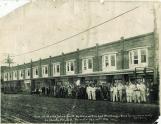1
Until the twentieth century, the main thrust of urban development in Toronto was along the lakeshore. The Don River and Valley formed a natural barrier from the city of Toronto to the west. Settlements east of the Don River were unincorporated and as a result, under-serviced. The natural isolation and lack of public services diminished the area's appeal to new immigrants and the Don Valley remained essentially rural until well after 1900.3
Don Mills Road, running parallel to the east bank of the Don River, had been established in 1799. It led to the villages of Chester and Todmorden but remained a dirt and gravel road well into the twentieth century.5
The unpaved road was dusty in the summer. In the winter, snowdrifts blocked traffic. The road became a sea of mud in the spring and autumn.A local joke:
Walking along the road in the spring, a man saw another man passing by. Only his head and shoulders were visible. "Rough walking," he said to the passerby. "Walking!" replied the man. "Who's walking? I'm riding a horse!"
7
In 1884, the area south of Danforth Avenue, north of Queen Street and extending from the Don River to Greenwood Avenue became part of Toronto. Annexation brought improvements in public service. In 1888, the Toronto Street Railway established a horse-drawn streetcar service along Broadview from Queen Street to the corner of Danforth Avenue. In 1909, the village of Chester, located south of Todmorden, was annexed to the city.Anticipating rapid growth in the area, local merchants responded by building stores along the south side of the Danforth.


